Project Leadership Assessment 2: Self-Development Plan Report
VerifiedAdded on 2021/05/31
|13
|3866
|318
Report
AI Summary
This report presents a self-development plan for project leadership, focusing on personal assessment, identification of instrumental values and weaknesses, and the selection of key leadership skills. The author identifies honesty and ambition as crucial instrumental values, highlighting their role in transformational leadership and entrepreneurial aspirations. The report acknowledges a weakness in team-working, recognizing the importance of effective team dynamics. The author also discusses the importance of direct communication and inspiring others as critical leadership skills. A development plan is outlined, with the goal of improving team management skills, including effective communication, constructive feedback, and fostering a supportive team environment. The author aims to enhance their leadership capabilities by addressing weaknesses and developing skills essential for successful project leadership. The report emphasizes the value of team management and its benefits in achieving organizational goals and fostering a positive work environment.
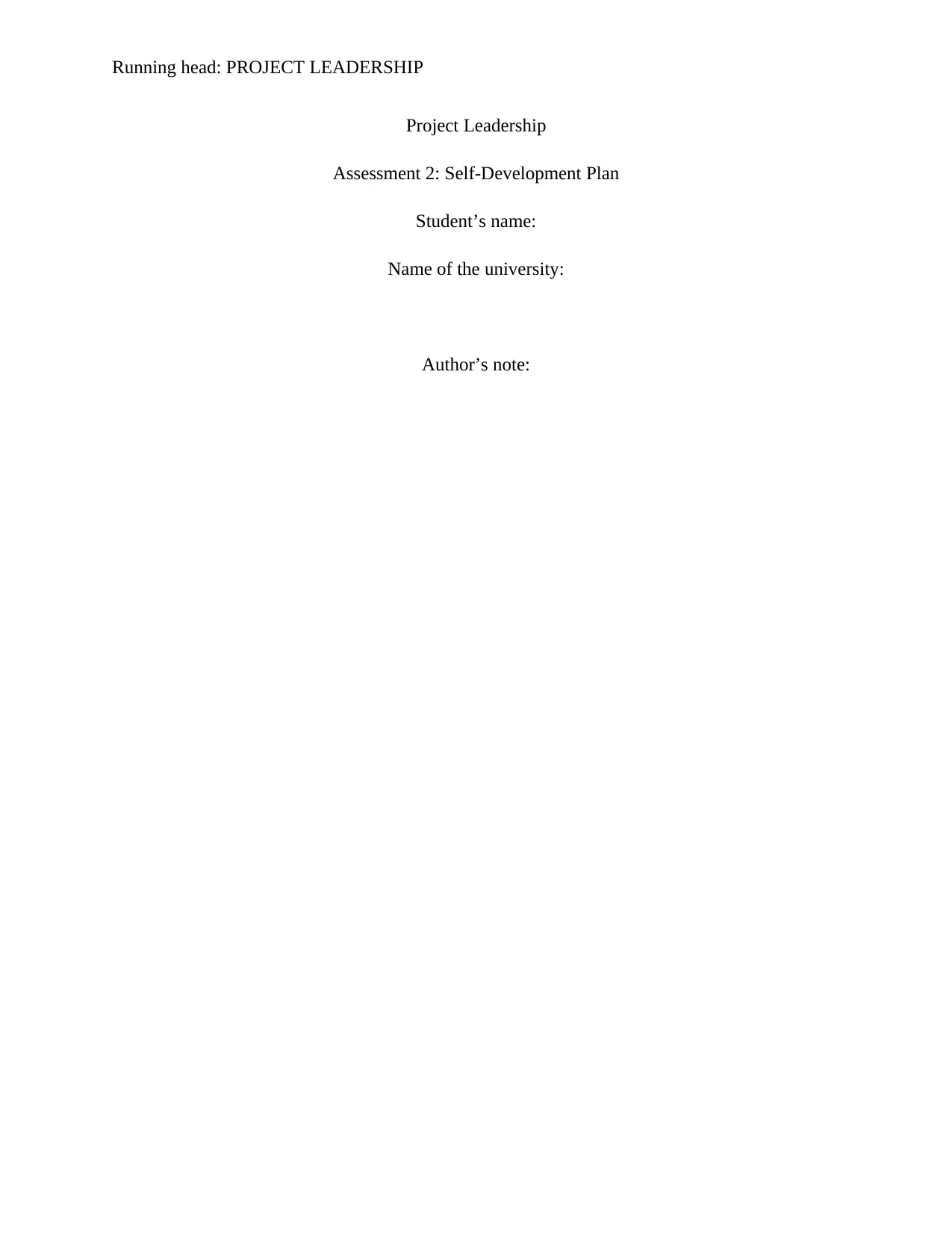
Running head: PROJECT LEADERSHIP
Project Leadership
Assessment 2: Self-Development Plan
Student’s name:
Name of the university:
Author’s note:
Project Leadership
Assessment 2: Self-Development Plan
Student’s name:
Name of the university:
Author’s note:
Paraphrase This Document
Need a fresh take? Get an instant paraphrase of this document with our AI Paraphraser
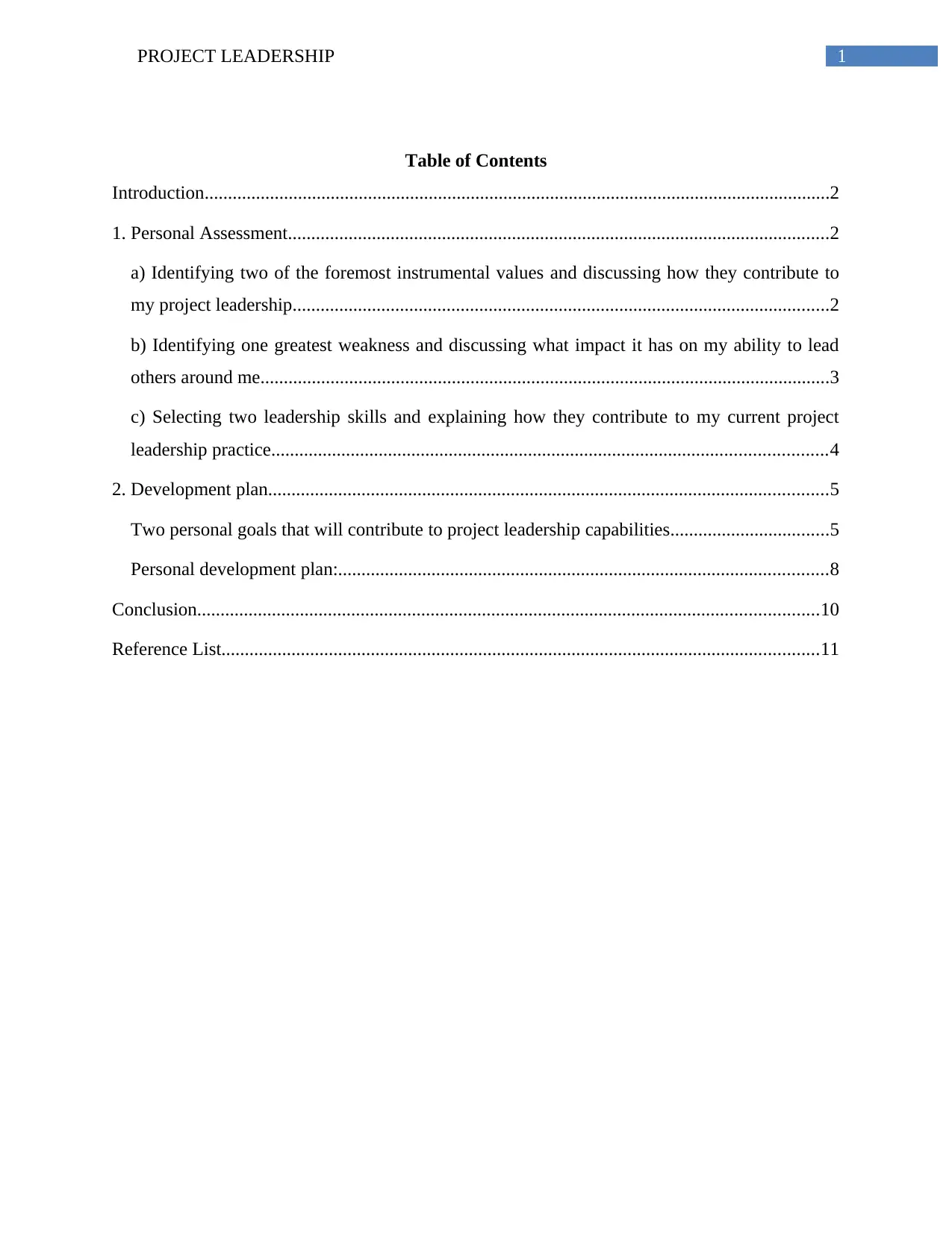
1PROJECT LEADERSHIP
Table of Contents
Introduction......................................................................................................................................2
1. Personal Assessment....................................................................................................................2
a) Identifying two of the foremost instrumental values and discussing how they contribute to
my project leadership...................................................................................................................2
b) Identifying one greatest weakness and discussing what impact it has on my ability to lead
others around me..........................................................................................................................3
c) Selecting two leadership skills and explaining how they contribute to my current project
leadership practice.......................................................................................................................4
2. Development plan........................................................................................................................5
Two personal goals that will contribute to project leadership capabilities..................................5
Personal development plan:.........................................................................................................8
Conclusion.....................................................................................................................................10
Reference List................................................................................................................................11
Table of Contents
Introduction......................................................................................................................................2
1. Personal Assessment....................................................................................................................2
a) Identifying two of the foremost instrumental values and discussing how they contribute to
my project leadership...................................................................................................................2
b) Identifying one greatest weakness and discussing what impact it has on my ability to lead
others around me..........................................................................................................................3
c) Selecting two leadership skills and explaining how they contribute to my current project
leadership practice.......................................................................................................................4
2. Development plan........................................................................................................................5
Two personal goals that will contribute to project leadership capabilities..................................5
Personal development plan:.........................................................................................................8
Conclusion.....................................................................................................................................10
Reference List................................................................................................................................11
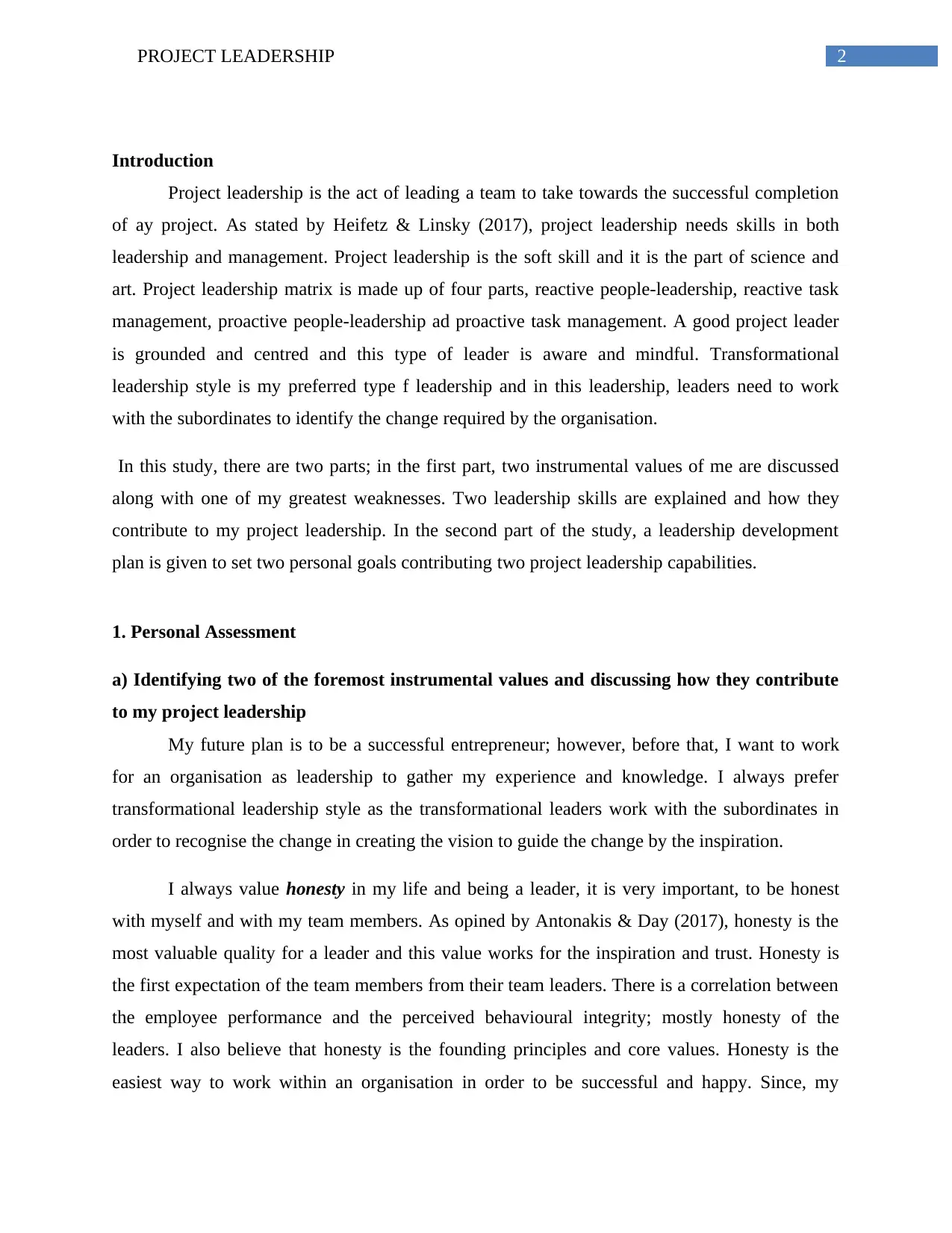
2PROJECT LEADERSHIP
Introduction
Project leadership is the act of leading a team to take towards the successful completion
of ay project. As stated by Heifetz & Linsky (2017), project leadership needs skills in both
leadership and management. Project leadership is the soft skill and it is the part of science and
art. Project leadership matrix is made up of four parts, reactive people-leadership, reactive task
management, proactive people-leadership ad proactive task management. A good project leader
is grounded and centred and this type of leader is aware and mindful. Transformational
leadership style is my preferred type f leadership and in this leadership, leaders need to work
with the subordinates to identify the change required by the organisation.
In this study, there are two parts; in the first part, two instrumental values of me are discussed
along with one of my greatest weaknesses. Two leadership skills are explained and how they
contribute to my project leadership. In the second part of the study, a leadership development
plan is given to set two personal goals contributing two project leadership capabilities.
1. Personal Assessment
a) Identifying two of the foremost instrumental values and discussing how they contribute
to my project leadership
My future plan is to be a successful entrepreneur; however, before that, I want to work
for an organisation as leadership to gather my experience and knowledge. I always prefer
transformational leadership style as the transformational leaders work with the subordinates in
order to recognise the change in creating the vision to guide the change by the inspiration.
I always value honesty in my life and being a leader, it is very important, to be honest
with myself and with my team members. As opined by Antonakis & Day (2017), honesty is the
most valuable quality for a leader and this value works for the inspiration and trust. Honesty is
the first expectation of the team members from their team leaders. There is a correlation between
the employee performance and the perceived behavioural integrity; mostly honesty of the
leaders. I also believe that honesty is the founding principles and core values. Honesty is the
easiest way to work within an organisation in order to be successful and happy. Since, my
Introduction
Project leadership is the act of leading a team to take towards the successful completion
of ay project. As stated by Heifetz & Linsky (2017), project leadership needs skills in both
leadership and management. Project leadership is the soft skill and it is the part of science and
art. Project leadership matrix is made up of four parts, reactive people-leadership, reactive task
management, proactive people-leadership ad proactive task management. A good project leader
is grounded and centred and this type of leader is aware and mindful. Transformational
leadership style is my preferred type f leadership and in this leadership, leaders need to work
with the subordinates to identify the change required by the organisation.
In this study, there are two parts; in the first part, two instrumental values of me are discussed
along with one of my greatest weaknesses. Two leadership skills are explained and how they
contribute to my project leadership. In the second part of the study, a leadership development
plan is given to set two personal goals contributing two project leadership capabilities.
1. Personal Assessment
a) Identifying two of the foremost instrumental values and discussing how they contribute
to my project leadership
My future plan is to be a successful entrepreneur; however, before that, I want to work
for an organisation as leadership to gather my experience and knowledge. I always prefer
transformational leadership style as the transformational leaders work with the subordinates in
order to recognise the change in creating the vision to guide the change by the inspiration.
I always value honesty in my life and being a leader, it is very important, to be honest
with myself and with my team members. As opined by Antonakis & Day (2017), honesty is the
most valuable quality for a leader and this value works for the inspiration and trust. Honesty is
the first expectation of the team members from their team leaders. There is a correlation between
the employee performance and the perceived behavioural integrity; mostly honesty of the
leaders. I also believe that honesty is the founding principles and core values. Honesty is the
easiest way to work within an organisation in order to be successful and happy. Since, my
⊘ This is a preview!⊘
Do you want full access?
Subscribe today to unlock all pages.

Trusted by 1+ million students worldwide
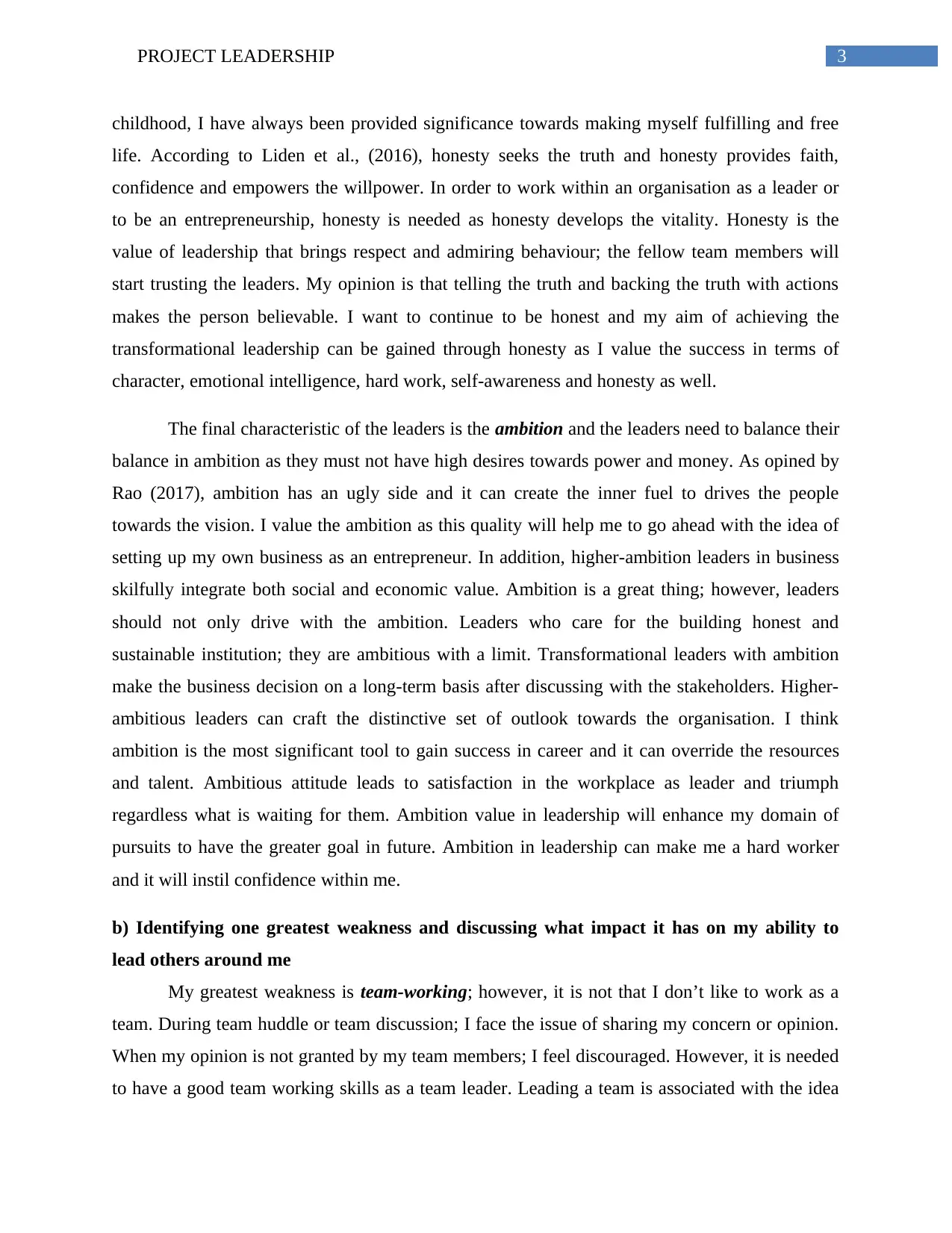
3PROJECT LEADERSHIP
childhood, I have always been provided significance towards making myself fulfilling and free
life. According to Liden et al., (2016), honesty seeks the truth and honesty provides faith,
confidence and empowers the willpower. In order to work within an organisation as a leader or
to be an entrepreneurship, honesty is needed as honesty develops the vitality. Honesty is the
value of leadership that brings respect and admiring behaviour; the fellow team members will
start trusting the leaders. My opinion is that telling the truth and backing the truth with actions
makes the person believable. I want to continue to be honest and my aim of achieving the
transformational leadership can be gained through honesty as I value the success in terms of
character, emotional intelligence, hard work, self-awareness and honesty as well.
The final characteristic of the leaders is the ambition and the leaders need to balance their
balance in ambition as they must not have high desires towards power and money. As opined by
Rao (2017), ambition has an ugly side and it can create the inner fuel to drives the people
towards the vision. I value the ambition as this quality will help me to go ahead with the idea of
setting up my own business as an entrepreneur. In addition, higher-ambition leaders in business
skilfully integrate both social and economic value. Ambition is a great thing; however, leaders
should not only drive with the ambition. Leaders who care for the building honest and
sustainable institution; they are ambitious with a limit. Transformational leaders with ambition
make the business decision on a long-term basis after discussing with the stakeholders. Higher-
ambitious leaders can craft the distinctive set of outlook towards the organisation. I think
ambition is the most significant tool to gain success in career and it can override the resources
and talent. Ambitious attitude leads to satisfaction in the workplace as leader and triumph
regardless what is waiting for them. Ambition value in leadership will enhance my domain of
pursuits to have the greater goal in future. Ambition in leadership can make me a hard worker
and it will instil confidence within me.
b) Identifying one greatest weakness and discussing what impact it has on my ability to
lead others around me
My greatest weakness is team-working; however, it is not that I don’t like to work as a
team. During team huddle or team discussion; I face the issue of sharing my concern or opinion.
When my opinion is not granted by my team members; I feel discouraged. However, it is needed
to have a good team working skills as a team leader. Leading a team is associated with the idea
childhood, I have always been provided significance towards making myself fulfilling and free
life. According to Liden et al., (2016), honesty seeks the truth and honesty provides faith,
confidence and empowers the willpower. In order to work within an organisation as a leader or
to be an entrepreneurship, honesty is needed as honesty develops the vitality. Honesty is the
value of leadership that brings respect and admiring behaviour; the fellow team members will
start trusting the leaders. My opinion is that telling the truth and backing the truth with actions
makes the person believable. I want to continue to be honest and my aim of achieving the
transformational leadership can be gained through honesty as I value the success in terms of
character, emotional intelligence, hard work, self-awareness and honesty as well.
The final characteristic of the leaders is the ambition and the leaders need to balance their
balance in ambition as they must not have high desires towards power and money. As opined by
Rao (2017), ambition has an ugly side and it can create the inner fuel to drives the people
towards the vision. I value the ambition as this quality will help me to go ahead with the idea of
setting up my own business as an entrepreneur. In addition, higher-ambition leaders in business
skilfully integrate both social and economic value. Ambition is a great thing; however, leaders
should not only drive with the ambition. Leaders who care for the building honest and
sustainable institution; they are ambitious with a limit. Transformational leaders with ambition
make the business decision on a long-term basis after discussing with the stakeholders. Higher-
ambitious leaders can craft the distinctive set of outlook towards the organisation. I think
ambition is the most significant tool to gain success in career and it can override the resources
and talent. Ambitious attitude leads to satisfaction in the workplace as leader and triumph
regardless what is waiting for them. Ambition value in leadership will enhance my domain of
pursuits to have the greater goal in future. Ambition in leadership can make me a hard worker
and it will instil confidence within me.
b) Identifying one greatest weakness and discussing what impact it has on my ability to
lead others around me
My greatest weakness is team-working; however, it is not that I don’t like to work as a
team. During team huddle or team discussion; I face the issue of sharing my concern or opinion.
When my opinion is not granted by my team members; I feel discouraged. However, it is needed
to have a good team working skills as a team leader. Leading a team is associated with the idea
Paraphrase This Document
Need a fresh take? Get an instant paraphrase of this document with our AI Paraphraser
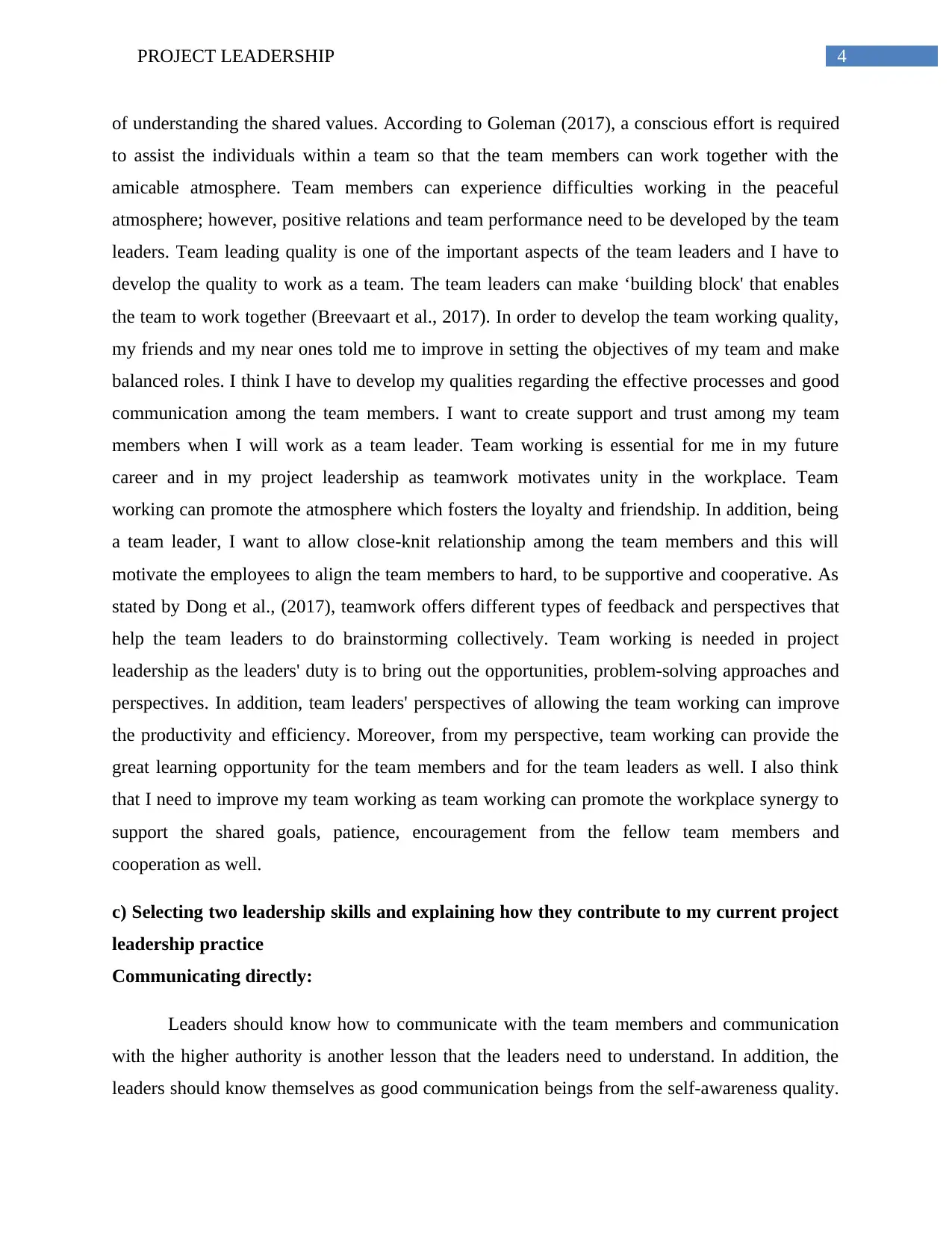
4PROJECT LEADERSHIP
of understanding the shared values. According to Goleman (2017), a conscious effort is required
to assist the individuals within a team so that the team members can work together with the
amicable atmosphere. Team members can experience difficulties working in the peaceful
atmosphere; however, positive relations and team performance need to be developed by the team
leaders. Team leading quality is one of the important aspects of the team leaders and I have to
develop the quality to work as a team. The team leaders can make ‘building block' that enables
the team to work together (Breevaart et al., 2017). In order to develop the team working quality,
my friends and my near ones told me to improve in setting the objectives of my team and make
balanced roles. I think I have to develop my qualities regarding the effective processes and good
communication among the team members. I want to create support and trust among my team
members when I will work as a team leader. Team working is essential for me in my future
career and in my project leadership as teamwork motivates unity in the workplace. Team
working can promote the atmosphere which fosters the loyalty and friendship. In addition, being
a team leader, I want to allow close-knit relationship among the team members and this will
motivate the employees to align the team members to hard, to be supportive and cooperative. As
stated by Dong et al., (2017), teamwork offers different types of feedback and perspectives that
help the team leaders to do brainstorming collectively. Team working is needed in project
leadership as the leaders' duty is to bring out the opportunities, problem-solving approaches and
perspectives. In addition, team leaders' perspectives of allowing the team working can improve
the productivity and efficiency. Moreover, from my perspective, team working can provide the
great learning opportunity for the team members and for the team leaders as well. I also think
that I need to improve my team working as team working can promote the workplace synergy to
support the shared goals, patience, encouragement from the fellow team members and
cooperation as well.
c) Selecting two leadership skills and explaining how they contribute to my current project
leadership practice
Communicating directly:
Leaders should know how to communicate with the team members and communication
with the higher authority is another lesson that the leaders need to understand. In addition, the
leaders should know themselves as good communication beings from the self-awareness quality.
of understanding the shared values. According to Goleman (2017), a conscious effort is required
to assist the individuals within a team so that the team members can work together with the
amicable atmosphere. Team members can experience difficulties working in the peaceful
atmosphere; however, positive relations and team performance need to be developed by the team
leaders. Team leading quality is one of the important aspects of the team leaders and I have to
develop the quality to work as a team. The team leaders can make ‘building block' that enables
the team to work together (Breevaart et al., 2017). In order to develop the team working quality,
my friends and my near ones told me to improve in setting the objectives of my team and make
balanced roles. I think I have to develop my qualities regarding the effective processes and good
communication among the team members. I want to create support and trust among my team
members when I will work as a team leader. Team working is essential for me in my future
career and in my project leadership as teamwork motivates unity in the workplace. Team
working can promote the atmosphere which fosters the loyalty and friendship. In addition, being
a team leader, I want to allow close-knit relationship among the team members and this will
motivate the employees to align the team members to hard, to be supportive and cooperative. As
stated by Dong et al., (2017), teamwork offers different types of feedback and perspectives that
help the team leaders to do brainstorming collectively. Team working is needed in project
leadership as the leaders' duty is to bring out the opportunities, problem-solving approaches and
perspectives. In addition, team leaders' perspectives of allowing the team working can improve
the productivity and efficiency. Moreover, from my perspective, team working can provide the
great learning opportunity for the team members and for the team leaders as well. I also think
that I need to improve my team working as team working can promote the workplace synergy to
support the shared goals, patience, encouragement from the fellow team members and
cooperation as well.
c) Selecting two leadership skills and explaining how they contribute to my current project
leadership practice
Communicating directly:
Leaders should know how to communicate with the team members and communication
with the higher authority is another lesson that the leaders need to understand. In addition, the
leaders should know themselves as good communication beings from the self-awareness quality.
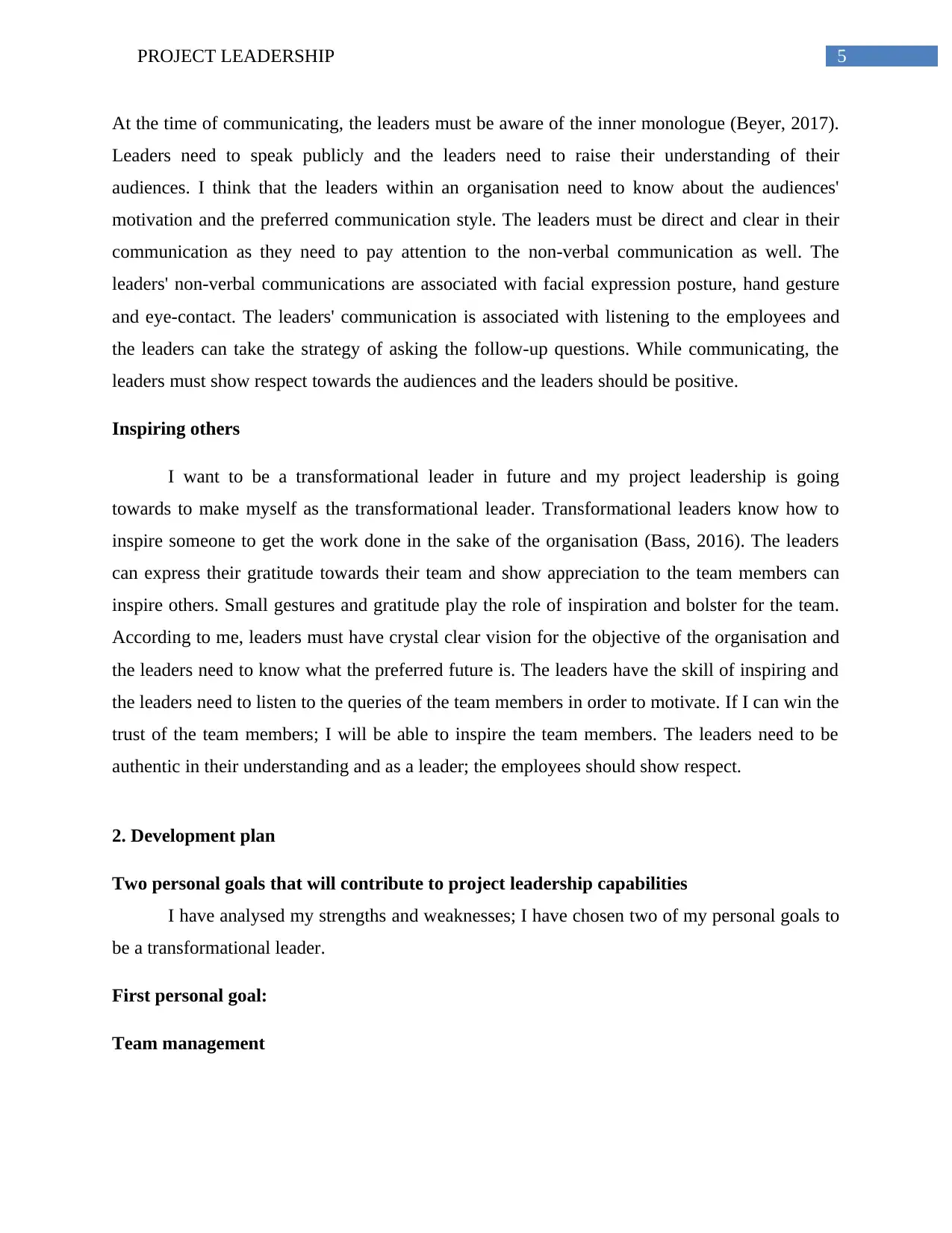
5PROJECT LEADERSHIP
At the time of communicating, the leaders must be aware of the inner monologue (Beyer, 2017).
Leaders need to speak publicly and the leaders need to raise their understanding of their
audiences. I think that the leaders within an organisation need to know about the audiences'
motivation and the preferred communication style. The leaders must be direct and clear in their
communication as they need to pay attention to the non-verbal communication as well. The
leaders' non-verbal communications are associated with facial expression posture, hand gesture
and eye-contact. The leaders' communication is associated with listening to the employees and
the leaders can take the strategy of asking the follow-up questions. While communicating, the
leaders must show respect towards the audiences and the leaders should be positive.
Inspiring others
I want to be a transformational leader in future and my project leadership is going
towards to make myself as the transformational leader. Transformational leaders know how to
inspire someone to get the work done in the sake of the organisation (Bass, 2016). The leaders
can express their gratitude towards their team and show appreciation to the team members can
inspire others. Small gestures and gratitude play the role of inspiration and bolster for the team.
According to me, leaders must have crystal clear vision for the objective of the organisation and
the leaders need to know what the preferred future is. The leaders have the skill of inspiring and
the leaders need to listen to the queries of the team members in order to motivate. If I can win the
trust of the team members; I will be able to inspire the team members. The leaders need to be
authentic in their understanding and as a leader; the employees should show respect.
2. Development plan
Two personal goals that will contribute to project leadership capabilities
I have analysed my strengths and weaknesses; I have chosen two of my personal goals to
be a transformational leader.
First personal goal:
Team management
At the time of communicating, the leaders must be aware of the inner monologue (Beyer, 2017).
Leaders need to speak publicly and the leaders need to raise their understanding of their
audiences. I think that the leaders within an organisation need to know about the audiences'
motivation and the preferred communication style. The leaders must be direct and clear in their
communication as they need to pay attention to the non-verbal communication as well. The
leaders' non-verbal communications are associated with facial expression posture, hand gesture
and eye-contact. The leaders' communication is associated with listening to the employees and
the leaders can take the strategy of asking the follow-up questions. While communicating, the
leaders must show respect towards the audiences and the leaders should be positive.
Inspiring others
I want to be a transformational leader in future and my project leadership is going
towards to make myself as the transformational leader. Transformational leaders know how to
inspire someone to get the work done in the sake of the organisation (Bass, 2016). The leaders
can express their gratitude towards their team and show appreciation to the team members can
inspire others. Small gestures and gratitude play the role of inspiration and bolster for the team.
According to me, leaders must have crystal clear vision for the objective of the organisation and
the leaders need to know what the preferred future is. The leaders have the skill of inspiring and
the leaders need to listen to the queries of the team members in order to motivate. If I can win the
trust of the team members; I will be able to inspire the team members. The leaders need to be
authentic in their understanding and as a leader; the employees should show respect.
2. Development plan
Two personal goals that will contribute to project leadership capabilities
I have analysed my strengths and weaknesses; I have chosen two of my personal goals to
be a transformational leader.
First personal goal:
Team management
⊘ This is a preview!⊘
Do you want full access?
Subscribe today to unlock all pages.

Trusted by 1+ million students worldwide
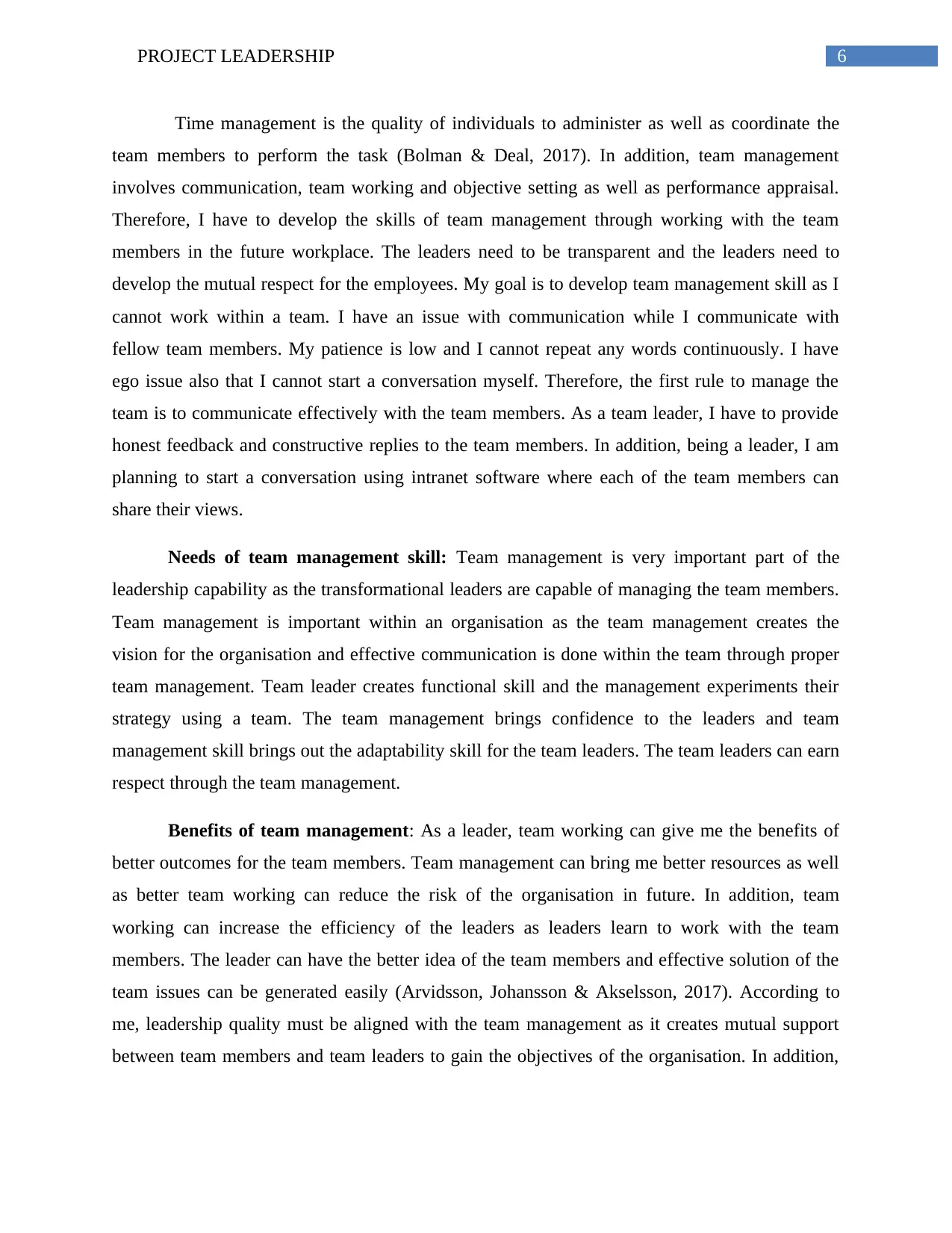
6PROJECT LEADERSHIP
Time management is the quality of individuals to administer as well as coordinate the
team members to perform the task (Bolman & Deal, 2017). In addition, team management
involves communication, team working and objective setting as well as performance appraisal.
Therefore, I have to develop the skills of team management through working with the team
members in the future workplace. The leaders need to be transparent and the leaders need to
develop the mutual respect for the employees. My goal is to develop team management skill as I
cannot work within a team. I have an issue with communication while I communicate with
fellow team members. My patience is low and I cannot repeat any words continuously. I have
ego issue also that I cannot start a conversation myself. Therefore, the first rule to manage the
team is to communicate effectively with the team members. As a team leader, I have to provide
honest feedback and constructive replies to the team members. In addition, being a leader, I am
planning to start a conversation using intranet software where each of the team members can
share their views.
Needs of team management skill: Team management is very important part of the
leadership capability as the transformational leaders are capable of managing the team members.
Team management is important within an organisation as the team management creates the
vision for the organisation and effective communication is done within the team through proper
team management. Team leader creates functional skill and the management experiments their
strategy using a team. The team management brings confidence to the leaders and team
management skill brings out the adaptability skill for the team leaders. The team leaders can earn
respect through the team management.
Benefits of team management: As a leader, team working can give me the benefits of
better outcomes for the team members. Team management can bring me better resources as well
as better team working can reduce the risk of the organisation in future. In addition, team
working can increase the efficiency of the leaders as leaders learn to work with the team
members. The leader can have the better idea of the team members and effective solution of the
team issues can be generated easily (Arvidsson, Johansson & Akselsson, 2017). According to
me, leadership quality must be aligned with the team management as it creates mutual support
between team members and team leaders to gain the objectives of the organisation. In addition,
Time management is the quality of individuals to administer as well as coordinate the
team members to perform the task (Bolman & Deal, 2017). In addition, team management
involves communication, team working and objective setting as well as performance appraisal.
Therefore, I have to develop the skills of team management through working with the team
members in the future workplace. The leaders need to be transparent and the leaders need to
develop the mutual respect for the employees. My goal is to develop team management skill as I
cannot work within a team. I have an issue with communication while I communicate with
fellow team members. My patience is low and I cannot repeat any words continuously. I have
ego issue also that I cannot start a conversation myself. Therefore, the first rule to manage the
team is to communicate effectively with the team members. As a team leader, I have to provide
honest feedback and constructive replies to the team members. In addition, being a leader, I am
planning to start a conversation using intranet software where each of the team members can
share their views.
Needs of team management skill: Team management is very important part of the
leadership capability as the transformational leaders are capable of managing the team members.
Team management is important within an organisation as the team management creates the
vision for the organisation and effective communication is done within the team through proper
team management. Team leader creates functional skill and the management experiments their
strategy using a team. The team management brings confidence to the leaders and team
management skill brings out the adaptability skill for the team leaders. The team leaders can earn
respect through the team management.
Benefits of team management: As a leader, team working can give me the benefits of
better outcomes for the team members. Team management can bring me better resources as well
as better team working can reduce the risk of the organisation in future. In addition, team
working can increase the efficiency of the leaders as leaders learn to work with the team
members. The leader can have the better idea of the team members and effective solution of the
team issues can be generated easily (Arvidsson, Johansson & Akselsson, 2017). According to
me, leadership quality must be aligned with the team management as it creates mutual support
between team members and team leaders to gain the objectives of the organisation. In addition,
Paraphrase This Document
Need a fresh take? Get an instant paraphrase of this document with our AI Paraphraser

7PROJECT LEADERSHIP
team management goal will give me a sense of accomplishment about what an employee feels
while working with me.
Second personal goal:
Strategic Thinking
Strategic thinking is the process to define the manner of thinking capability of the
individual and it is also the process of assessing, creating and viewing the manner within an
organisation (McCleskey, 2014). Strategic thinking skill is a valuable tool and it is extremely
effective to build up the leaders' decision-making ability. The leaders can apply the strategic
thinking in order to arrive at the decisions of organisational objectives and business situation. I
did apprenticeship from one of the leading international organisations in Sydney. During that
period; my team leader told me that strategic thinking is very difficult to acquire as it is about
setting the mindset. In that workplace, I had to maintain the tactical responses to immediate
demands are rewarded over long-term vision. My dream is to be true strategic leaders to build
the commitment of the stakeholders by inviting others to the strategic process.
Needs of strategic thinking skill: I need to develop the strategic thinking skill as I
always take a decision in hurry in my personal life without thinking twice about my future or the
consequences. It is my bad habit not to define logically before taking any decision. In case of the
future career life, I need to have the ability to use the logical and creative sides of the brain. This
skill will help to do the practice to make myself valuable and confident in the future career. In
addition, critical thinkers have the ability to learn about the organisational objectives and they
develop the strategic plan in order to meet the objectives of the organisation. I want to develop
my strategic thinking ability to design the flexibility by creating the benchmark of the review to
learn about progress. The leaders within the organisation learn the benchmark to be a guide to
recognise the opportunity to revise the plan. I want the personal goal of strategic leadership to
recognise the external and internal cues that are suitable for the organisation.
Benefits of strategic thinking: As a leader, I want to take strategic actions with a right
decision within the organisation in future. In an organisation or in entrepreneurship practices,
leaders take the decisions of complexity, chaos and ambiguity of the businesses (Banks et al.,
2016). The benefits of strategic thinking are having the benefits of leading the edge of the
team management goal will give me a sense of accomplishment about what an employee feels
while working with me.
Second personal goal:
Strategic Thinking
Strategic thinking is the process to define the manner of thinking capability of the
individual and it is also the process of assessing, creating and viewing the manner within an
organisation (McCleskey, 2014). Strategic thinking skill is a valuable tool and it is extremely
effective to build up the leaders' decision-making ability. The leaders can apply the strategic
thinking in order to arrive at the decisions of organisational objectives and business situation. I
did apprenticeship from one of the leading international organisations in Sydney. During that
period; my team leader told me that strategic thinking is very difficult to acquire as it is about
setting the mindset. In that workplace, I had to maintain the tactical responses to immediate
demands are rewarded over long-term vision. My dream is to be true strategic leaders to build
the commitment of the stakeholders by inviting others to the strategic process.
Needs of strategic thinking skill: I need to develop the strategic thinking skill as I
always take a decision in hurry in my personal life without thinking twice about my future or the
consequences. It is my bad habit not to define logically before taking any decision. In case of the
future career life, I need to have the ability to use the logical and creative sides of the brain. This
skill will help to do the practice to make myself valuable and confident in the future career. In
addition, critical thinkers have the ability to learn about the organisational objectives and they
develop the strategic plan in order to meet the objectives of the organisation. I want to develop
my strategic thinking ability to design the flexibility by creating the benchmark of the review to
learn about progress. The leaders within the organisation learn the benchmark to be a guide to
recognise the opportunity to revise the plan. I want the personal goal of strategic leadership to
recognise the external and internal cues that are suitable for the organisation.
Benefits of strategic thinking: As a leader, I want to take strategic actions with a right
decision within the organisation in future. In an organisation or in entrepreneurship practices,
leaders take the decisions of complexity, chaos and ambiguity of the businesses (Banks et al.,
2016). The benefits of strategic thinking are having the benefits of leading the edge of the

8PROJECT LEADERSHIP
change. It can optimise the ability to leverage the change within the organisation. I will be able
to eliminate the complacency and I will be able to create the sense of unity through the strategic
decision-making capability. Benefits of strategic thinking will provide me with the idea of
proactive leadership. Strategic thinking is the systematical process of becoming a life-long
learning organisation.
Personal development plan:
Priority Outcome,
objective
or area of
improveme
nt
Action
planned
Support
resources
Target
and
actual
dates
Review
date
Indicators
of success
Short-term Goal
Communica
tion
To improve
communica
tion skill
while
speaking
publicly
and with
the team
members
for a better
managemen
t team
1.
Improveme
nt of verbal
and non-
verbal
communica
tion
2. Short
communica
tion courses
3. Active
listening
skills
Communicat
ion-based
books,
Internet
Printed
materials
Within 3
months
(01.08.20
18)
01.09.20
18
I will be
able to speak
publicly. I
will
consolidate
my
communicati
on skill with
others.
Mid-term Goal
Strategic
thinking and
decision
making
To come up
with
effective
plans for
the
1. I need to
know about
the latest
trend and
Books,
Printed
materials
Within
six
months
01.04.20
19
I will be
able to play
the role o
business
change. It can optimise the ability to leverage the change within the organisation. I will be able
to eliminate the complacency and I will be able to create the sense of unity through the strategic
decision-making capability. Benefits of strategic thinking will provide me with the idea of
proactive leadership. Strategic thinking is the systematical process of becoming a life-long
learning organisation.
Personal development plan:
Priority Outcome,
objective
or area of
improveme
nt
Action
planned
Support
resources
Target
and
actual
dates
Review
date
Indicators
of success
Short-term Goal
Communica
tion
To improve
communica
tion skill
while
speaking
publicly
and with
the team
members
for a better
managemen
t team
1.
Improveme
nt of verbal
and non-
verbal
communica
tion
2. Short
communica
tion courses
3. Active
listening
skills
Communicat
ion-based
books,
Internet
Printed
materials
Within 3
months
(01.08.20
18)
01.09.20
18
I will be
able to speak
publicly. I
will
consolidate
my
communicati
on skill with
others.
Mid-term Goal
Strategic
thinking and
decision
making
To come up
with
effective
plans for
the
1. I need to
know about
the latest
trend and
Books,
Printed
materials
Within
six
months
01.04.20
19
I will be
able to play
the role o
business
⊘ This is a preview!⊘
Do you want full access?
Subscribe today to unlock all pages.

Trusted by 1+ million students worldwide
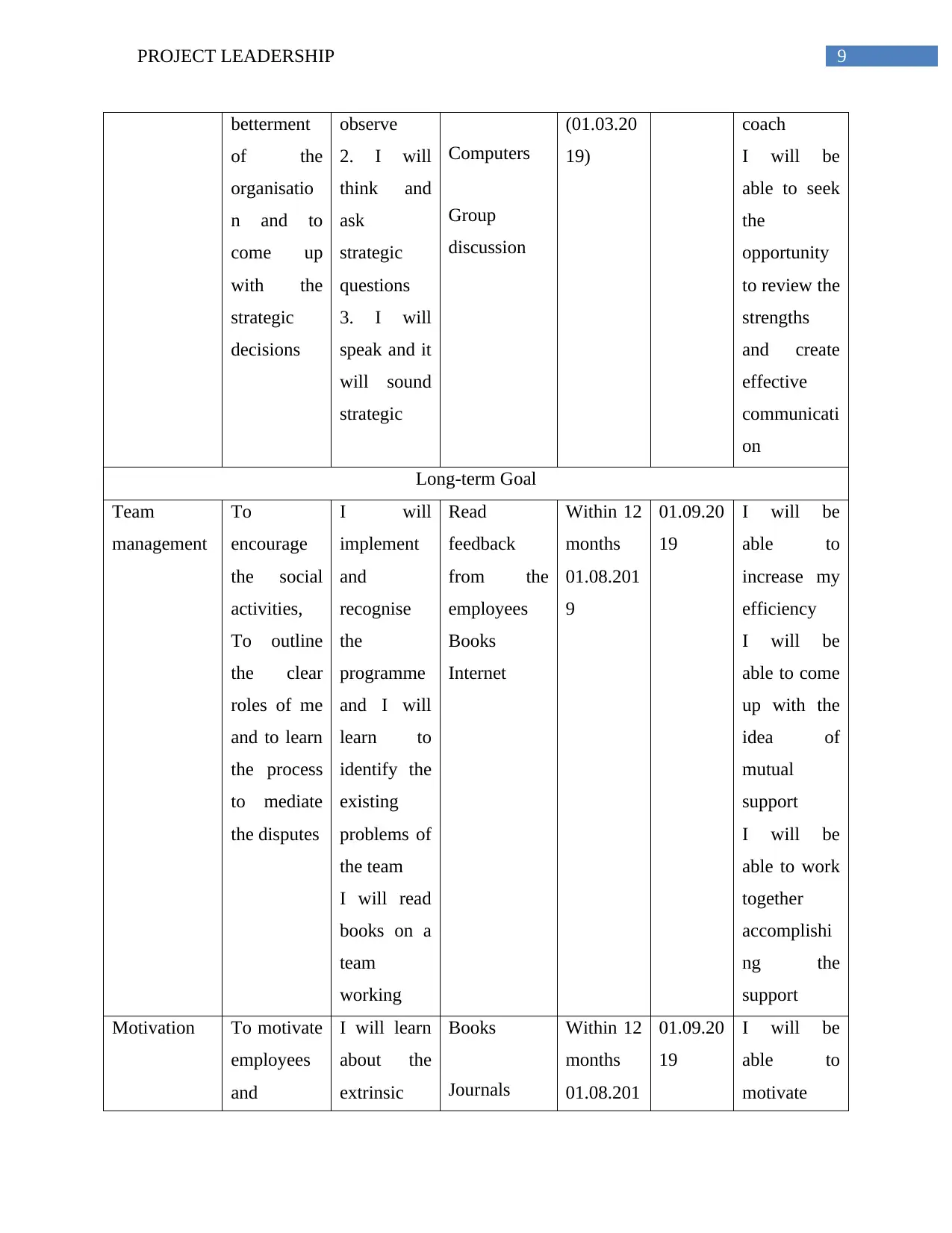
9PROJECT LEADERSHIP
betterment
of the
organisatio
n and to
come up
with the
strategic
decisions
observe
2. I will
think and
ask
strategic
questions
3. I will
speak and it
will sound
strategic
Computers
Group
discussion
(01.03.20
19)
coach
I will be
able to seek
the
opportunity
to review the
strengths
and create
effective
communicati
on
Long-term Goal
Team
management
To
encourage
the social
activities,
To outline
the clear
roles of me
and to learn
the process
to mediate
the disputes
I will
implement
and
recognise
the
programme
and I will
learn to
identify the
existing
problems of
the team
I will read
books on a
team
working
Read
feedback
from the
employees
Books
Internet
Within 12
months
01.08.201
9
01.09.20
19
I will be
able to
increase my
efficiency
I will be
able to come
up with the
idea of
mutual
support
I will be
able to work
together
accomplishi
ng the
support
Motivation To motivate
employees
and
I will learn
about the
extrinsic
Books
Journals
Within 12
months
01.08.201
01.09.20
19
I will be
able to
motivate
betterment
of the
organisatio
n and to
come up
with the
strategic
decisions
observe
2. I will
think and
ask
strategic
questions
3. I will
speak and it
will sound
strategic
Computers
Group
discussion
(01.03.20
19)
coach
I will be
able to seek
the
opportunity
to review the
strengths
and create
effective
communicati
on
Long-term Goal
Team
management
To
encourage
the social
activities,
To outline
the clear
roles of me
and to learn
the process
to mediate
the disputes
I will
implement
and
recognise
the
programme
and I will
learn to
identify the
existing
problems of
the team
I will read
books on a
team
working
Read
feedback
from the
employees
Books
Internet
Within 12
months
01.08.201
9
01.09.20
19
I will be
able to
increase my
efficiency
I will be
able to come
up with the
idea of
mutual
support
I will be
able to work
together
accomplishi
ng the
support
Motivation To motivate
employees
and
I will learn
about the
extrinsic
Books
Journals
Within 12
months
01.08.201
01.09.20
19
I will be
able to
motivate
Paraphrase This Document
Need a fresh take? Get an instant paraphrase of this document with our AI Paraphraser
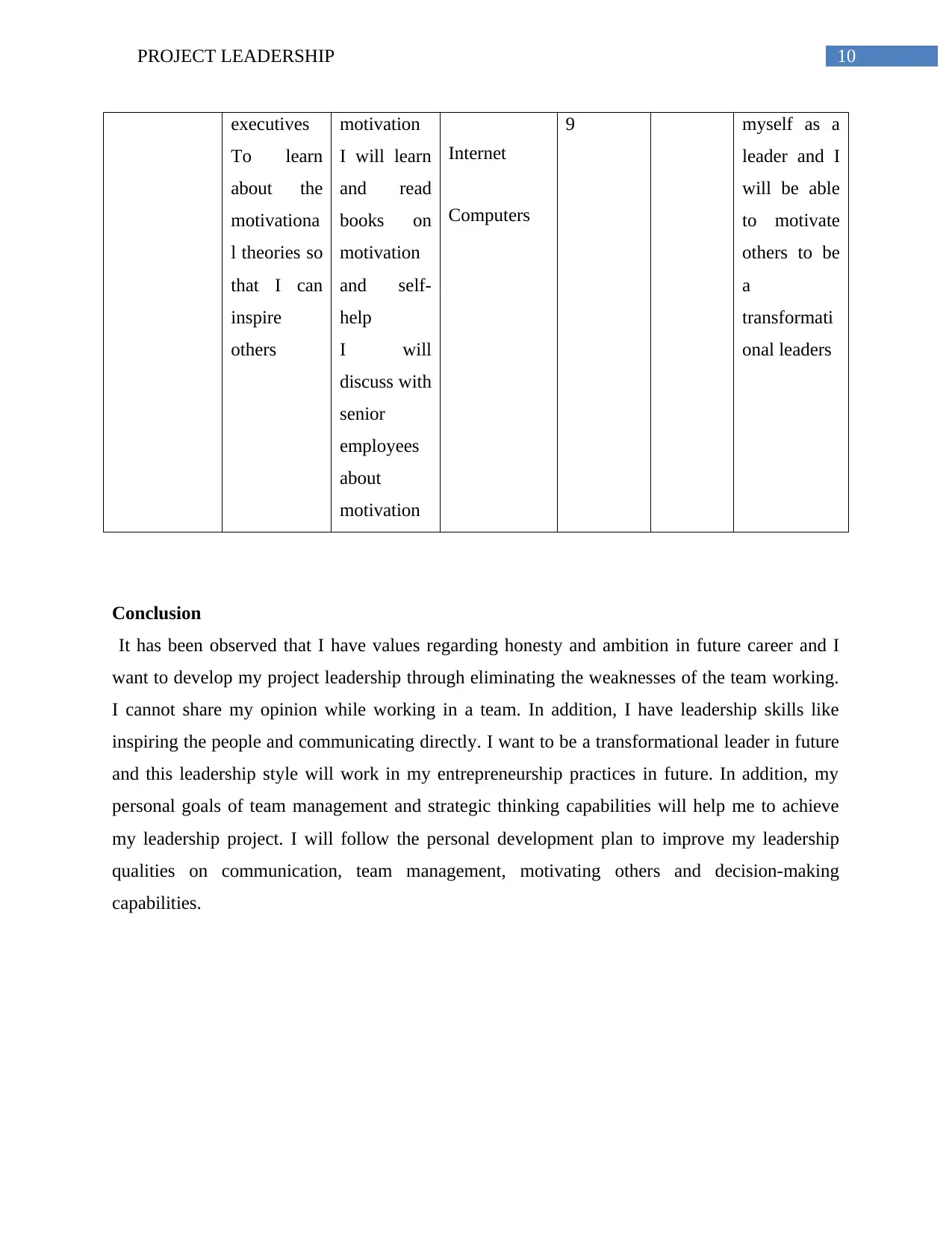
10PROJECT LEADERSHIP
executives
To learn
about the
motivationa
l theories so
that I can
inspire
others
motivation
I will learn
and read
books on
motivation
and self-
help
I will
discuss with
senior
employees
about
motivation
Internet
Computers
9 myself as a
leader and I
will be able
to motivate
others to be
a
transformati
onal leaders
Conclusion
It has been observed that I have values regarding honesty and ambition in future career and I
want to develop my project leadership through eliminating the weaknesses of the team working.
I cannot share my opinion while working in a team. In addition, I have leadership skills like
inspiring the people and communicating directly. I want to be a transformational leader in future
and this leadership style will work in my entrepreneurship practices in future. In addition, my
personal goals of team management and strategic thinking capabilities will help me to achieve
my leadership project. I will follow the personal development plan to improve my leadership
qualities on communication, team management, motivating others and decision-making
capabilities.
executives
To learn
about the
motivationa
l theories so
that I can
inspire
others
motivation
I will learn
and read
books on
motivation
and self-
help
I will
discuss with
senior
employees
about
motivation
Internet
Computers
9 myself as a
leader and I
will be able
to motivate
others to be
a
transformati
onal leaders
Conclusion
It has been observed that I have values regarding honesty and ambition in future career and I
want to develop my project leadership through eliminating the weaknesses of the team working.
I cannot share my opinion while working in a team. In addition, I have leadership skills like
inspiring the people and communicating directly. I want to be a transformational leader in future
and this leadership style will work in my entrepreneurship practices in future. In addition, my
personal goals of team management and strategic thinking capabilities will help me to achieve
my leadership project. I will follow the personal development plan to improve my leadership
qualities on communication, team management, motivating others and decision-making
capabilities.
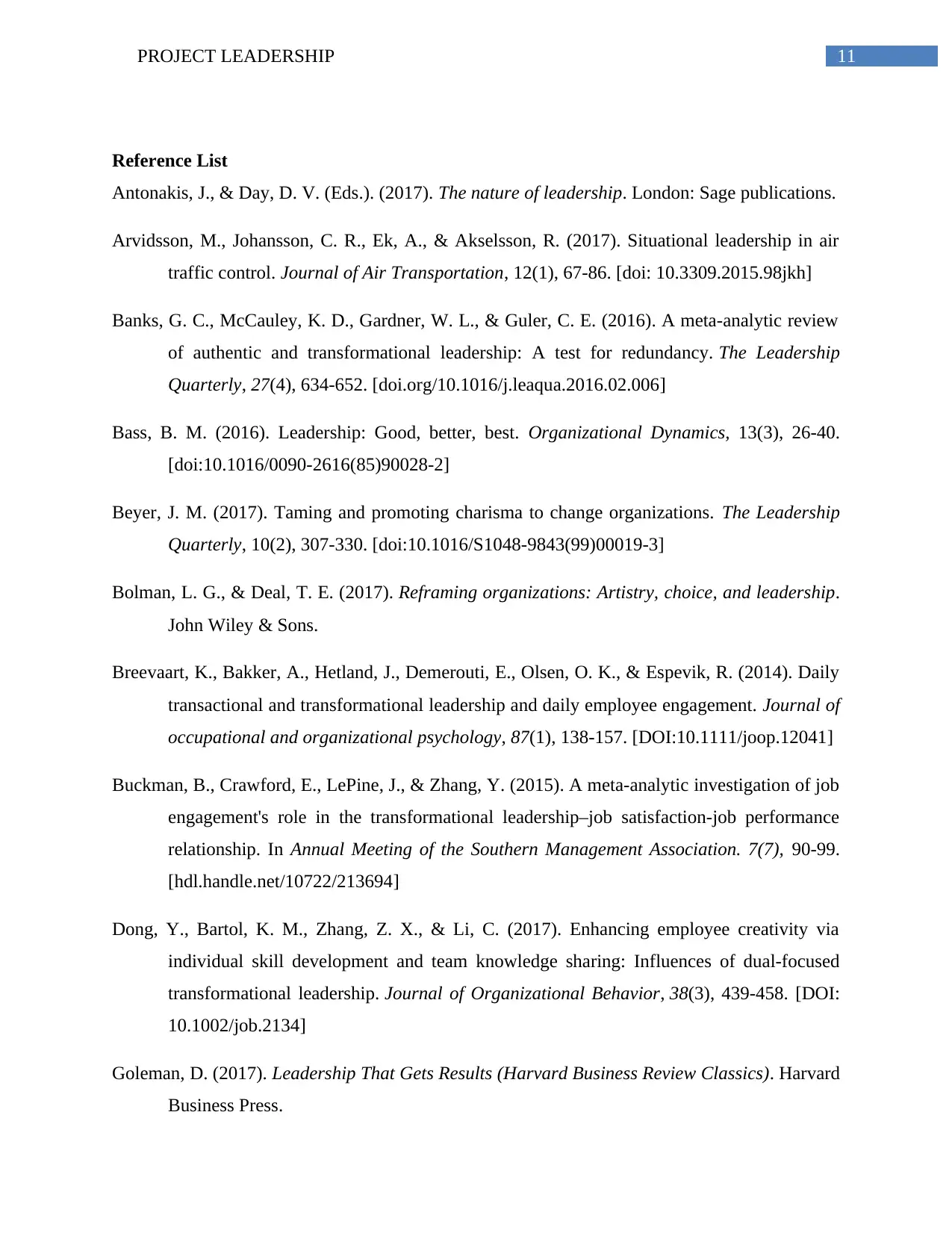
11PROJECT LEADERSHIP
Reference List
Antonakis, J., & Day, D. V. (Eds.). (2017). The nature of leadership. London: Sage publications.
Arvidsson, M., Johansson, C. R., Ek, A., & Akselsson, R. (2017). Situational leadership in air
traffic control. Journal of Air Transportation, 12(1), 67-86. [doi: 10.3309.2015.98jkh]
Banks, G. C., McCauley, K. D., Gardner, W. L., & Guler, C. E. (2016). A meta-analytic review
of authentic and transformational leadership: A test for redundancy. The Leadership
Quarterly, 27(4), 634-652. [doi.org/10.1016/j.leaqua.2016.02.006]
Bass, B. M. (2016). Leadership: Good, better, best. Organizational Dynamics, 13(3), 26-40.
[doi:10.1016/0090-2616(85)90028-2]
Beyer, J. M. (2017). Taming and promoting charisma to change organizations. The Leadership
Quarterly, 10(2), 307-330. [doi:10.1016/S1048-9843(99)00019-3]
Bolman, L. G., & Deal, T. E. (2017). Reframing organizations: Artistry, choice, and leadership.
John Wiley & Sons.
Breevaart, K., Bakker, A., Hetland, J., Demerouti, E., Olsen, O. K., & Espevik, R. (2014). Daily
transactional and transformational leadership and daily employee engagement. Journal of
occupational and organizational psychology, 87(1), 138-157. [DOI:10.1111/joop.12041]
Buckman, B., Crawford, E., LePine, J., & Zhang, Y. (2015). A meta-analytic investigation of job
engagement's role in the transformational leadership–job satisfaction-job performance
relationship. In Annual Meeting of the Southern Management Association. 7(7), 90-99.
[hdl.handle.net/10722/213694]
Dong, Y., Bartol, K. M., Zhang, Z. X., & Li, C. (2017). Enhancing employee creativity via
individual skill development and team knowledge sharing: Influences of dual‐focused
transformational leadership. Journal of Organizational Behavior, 38(3), 439-458. [DOI:
10.1002/job.2134]
Goleman, D. (2017). Leadership That Gets Results (Harvard Business Review Classics). Harvard
Business Press.
Reference List
Antonakis, J., & Day, D. V. (Eds.). (2017). The nature of leadership. London: Sage publications.
Arvidsson, M., Johansson, C. R., Ek, A., & Akselsson, R. (2017). Situational leadership in air
traffic control. Journal of Air Transportation, 12(1), 67-86. [doi: 10.3309.2015.98jkh]
Banks, G. C., McCauley, K. D., Gardner, W. L., & Guler, C. E. (2016). A meta-analytic review
of authentic and transformational leadership: A test for redundancy. The Leadership
Quarterly, 27(4), 634-652. [doi.org/10.1016/j.leaqua.2016.02.006]
Bass, B. M. (2016). Leadership: Good, better, best. Organizational Dynamics, 13(3), 26-40.
[doi:10.1016/0090-2616(85)90028-2]
Beyer, J. M. (2017). Taming and promoting charisma to change organizations. The Leadership
Quarterly, 10(2), 307-330. [doi:10.1016/S1048-9843(99)00019-3]
Bolman, L. G., & Deal, T. E. (2017). Reframing organizations: Artistry, choice, and leadership.
John Wiley & Sons.
Breevaart, K., Bakker, A., Hetland, J., Demerouti, E., Olsen, O. K., & Espevik, R. (2014). Daily
transactional and transformational leadership and daily employee engagement. Journal of
occupational and organizational psychology, 87(1), 138-157. [DOI:10.1111/joop.12041]
Buckman, B., Crawford, E., LePine, J., & Zhang, Y. (2015). A meta-analytic investigation of job
engagement's role in the transformational leadership–job satisfaction-job performance
relationship. In Annual Meeting of the Southern Management Association. 7(7), 90-99.
[hdl.handle.net/10722/213694]
Dong, Y., Bartol, K. M., Zhang, Z. X., & Li, C. (2017). Enhancing employee creativity via
individual skill development and team knowledge sharing: Influences of dual‐focused
transformational leadership. Journal of Organizational Behavior, 38(3), 439-458. [DOI:
10.1002/job.2134]
Goleman, D. (2017). Leadership That Gets Results (Harvard Business Review Classics). Harvard
Business Press.
⊘ This is a preview!⊘
Do you want full access?
Subscribe today to unlock all pages.

Trusted by 1+ million students worldwide
1 out of 13
Related Documents
Your All-in-One AI-Powered Toolkit for Academic Success.
+13062052269
info@desklib.com
Available 24*7 on WhatsApp / Email
![[object Object]](/_next/static/media/star-bottom.7253800d.svg)
Unlock your academic potential
Copyright © 2020–2025 A2Z Services. All Rights Reserved. Developed and managed by ZUCOL.



